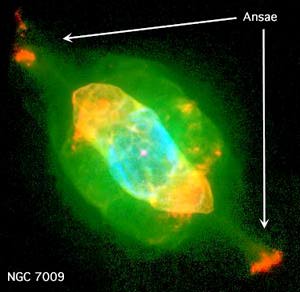
Traditional theory does not have such an easy time explaining ansae. In fact, there is no currently accepted theory on their origin.
"The most nagging mysteries [of planetary nebulae] deal with the so-called ansae -- bright knots of gas shooting away along the long axis of elliptical planetary nebulae. Their location and speed are the most troubling aspects. Ansae lie farther away from the star then the rest of the nebular gas, which means they must have been ejected early. They are also fast, expanding away from the star two or three times faster than anything else in the nebula.
The large speeds and distances associated with ansae led astronomers to think they were a kind of cosmic spitball -- dense blobs of matter shot out by the star just before it expelled the main portion of the nebula. Because no one offered any suggestion as to how this would occur, the idea simply substituted one mystery for another."
March 1997, Astronomy, pages 31-32
The Ball-of-Light Particle Model now offers a suggestion as to how ansae are formed.
The Ball-of-Light Particle Model predicts the core of a star is a ball-of-light. Explicitly, at the core of a star is a single object made of electric, magnetic and gravitational fields. On the surface of the core are electric and magnetic fields that are normally harmonic. These fields induce the smaller particles that make up the plasma that envelopes the core. (See also, Induction off the Sun's Core) Sometimes these fields become less harmonic and induce larger particles. For example, our sun's core typically ejects thousands of larger-than-normal balls-of-light into its plasma envelope every day. ("Normal" balls-of-light would be: electrons, protons, and other typical atomic nuclei.) (See also, Sunspots, and Blinkers)
There are many events that can destabilize the core of a star: a comet hitting (Large file! 245K Quicktime.mov), a meteor hitting, a large orbiting planet, an orbiting star, collision with another star, etc.
When the core is destabilized, large electromagnetic waves will sweep across the poles of the star, typically in opposite directions.
(Actually, the points on the core where the large electromagnetic waves originate and change direction will usually determine where the poles of the star are located. The exception is where the stars have a preexisting spin.)
When the electromagnetic waves reach the poles, they induce balls-of-light. These balls-of-light are ejected from the core at high speed due to electromagnetic repulsion. The following animated GIF demonstrates how electric fields (magenta) and magnetic fields (blue) might sweep across a ball-of-light and induce another ball-of-light off the pole.
When a major destabilizing event happens, causing a star's core to become destabilized, the ejected balls-of-light will burst through the outer plasma of a star in opposite directions creating the ansae. These ejected balls-of-light will very likely be unstable and will rapidly decay or explode. This accounts for the brightness of ansae. Also, ansae typically look like multiple "blobs" of material. Obviously, multiple balls-of-light could be ejected by the core. Not so obvious, is the additional possibility that the ejected balls-of-light might decay by splitting into smaller balls-of-light.
I believe Ansae will become known as the "signal flares" that mark the beginning of the creation of planetary nebula. It would be interesting to spot stars that are in this beginning stage of becoming a planetary nebula -- with just their Ansae popping out. ;-) To see a complete explanation of the creation of a bipolar planetary nebula, see Bipolar Ejection of Planetary Nebulae. The core of a star in this situation is extremely unstable, large electromagnetic waves will continue to violently sweep across the core. As these fields sweep across the core, they will eject the remaining outer plasma envelope from the star. This is what creates the main portion of nebula. This also explains why ansae are further out from the star than the rest of the nebula. An example of an object hitting a star, and causing material to be ejected is shown in the following animation. (I recommend stepping through the animation frame by frame.)
A comet, meteorite, or planet collides with the star. The collision creates a massive wave that sweeps across the enveloping plasma. The moving plasma wave induces waves on the core -- depicted by a solid black line. The wave on the core induces and ejects balls-of-light off the right pole, then rebounds and ejects more balls-of-light off the left pole.
Cat's Eye Nebulae Ansae
Another example of ansae can be seen in the famous Cat's Eye Nebula.
In the case of the Cat's Eye Nebulae, the impact object probably spiraled into the star. This is what created the spirals of ejected nebula that appeared after the ansae where ejected. After the core went through these two stages violent waves, the energy of the waves were partially dissipated This allowed the star to stabilize somewhat and eject material in a more spherical pattern. (The Ball-of-Light Particle Model predicts that if the star could not stabilize at this point it would catastrophically explode in a supernova.) Note, in most Planetary Nebulae, there is an evident pattern of waves that become more stable. If the waves do not become more stable, then a supernova would occur and the Planetary Nebulae would not be visible because it would be destroyed by the explosion.
The Glow of Ansae and the Nebulae
Traditional text on Planetary Nebulae explains that the glowing of the nebulae is a result of light from the central star being reflected off the surrounding gas and dust. The Ball-of-Light Particle Model predicts that some of the material ejected is composed of larger than normal balls-of-light. These larger than normal balls-of-light lie in a range of sizes that are inherently unstable. (See also, graph of Major Levels of Harmonic Energy) Thus, they rapidly decay. Thus much of the glow of the nebulae and ansae is created locally and is not a reflection.